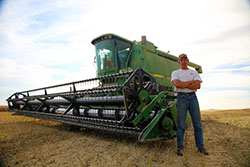|
|
|
|
|
Better Crops result from Better Management, not more fertilizer. |
|
|
| Almost always when
the production margin is very big you will find wasteful practices with
nutrients. These wasteful practices create superficial land values in relation to cash flow when the government backs it. Further investigation of big margin farming and you will find government policies at work supporting crops that are not competitive in the world market. The UK, France, Egypt and Mexico are the world's worst at getting nutrient efficiency improved. When you take a look at these wasteful countries you will find that No-till farming is not on the front burner. You will also discover that Anhydrous Ammonia is not directly applied and stabilized as TAPPS or TAPPKTS in pre-plant or side dress applications.
UAN and URAN are the primary sources of N in these
moderate climates. In the US wherever you find lots of tillage or a big margin, you will find polluted rivers, streams and drinking water that is not drinking water. How did nutrient use get to be so inefficient? 1. Government Policies. What crop is the worst with nutrients? I heard it was wheat. Since there is no world market for potatoes, you
will find non-competitive practices and in many cases overproduction. |
|
Are Canadian producers the best with
nutrients?
Case SDX banding 12 inch centers at 62.5 feet with Exactrix TAPPS
formulators in No-tillage farming at Manning, Alberta.
Walla Walla, Washington, Deep volcanic ash soils formed by the Cascade
volcanoes. Formed in 100,000 years, the deep soils could be non-productive
with 200 years of tillage.
Isn't one of problems with top yields/lower
cost per bushel due to lack of nutrient placement.
Why does Anhydrous Ammonia always produce the highest yields even with
the old pressure reducing NH3 Systems? |
 |
 |
|
10. Dryland Corn has 6 foot deep root system. |
11. Irrigated Corn has a 3 to 4 foot deep root system and requires a cover crop to remove all the nitrate and break the disease cycle. |
| Why do No-till farmers have such an advantage
using Rotational Band Loading? Roots are not able to locate fertilizer based on smell, feel, or some type of tropic response to pH. Roots find nutrients and when they do, the roots colonized. At highest level of efficiency, only 30% of the placed P can be utilized in the crop. The highest performance of nutrients is always in a balance of nutrients. NPKS are applied together in a crystallized form. TAPPS and TAPPKTS is a good example. If the nutrient is applied to surface it is generally not nearly as effective, since roots do not develop on the surface. Roots do best where there is moisture to support the plant above the ground line...whereby drought can be a significant part of the puzzle of raising a good crop with a pivot. Many producers think that pivots do not starve for moisture. These producers need to go check out their lawn sprinkler and figure out where to put the water. Roots prefer the nutrients deeper to bring on the colony. Roots prefer a constant supply of nutrient and water. Thus Fertilizer is not really plant food. Fertilizer is really a stimulant to allow roots to proliferate and absorb water to support the plant above the ground line. This is a big reason why strip till took off, as the root colony is located in consistent soil moisture with pivots or natural rainfall. A dermal treatment of penicillin is not nearly as effective in controlling infection. A lineal stream flow into the target path of blood flow does the most good at about 1/10th the rate. |
|
|
| Why does Alfalfa work so well in rotation? Deep rooted Alfalfa was considered a good crop in corn production rotation prior to NH3. From 1955 to 1965, Alfalfa began to disappear as a rotation crop. Alfalfa makes a uniform distribution of nitrogen, since it has many years to nodulate and deliver high quality carbon, nitrogen, phosphate and potassium into the depths of the profile. Alfalfa is right up there with earthworms in improving soil tilth and percolation. Nutrients cannot mask Alfalfa properly, since nutrients can be mechanically banded to about 7 to 10 inch depths. Until recently, it was not possible to deliver nutrients uniformly. Exactrix now delivers all nutrients within 1% CV. In fact, Alfalfa has the greatest potential to reduce nutrient cost if it is introduced into the rotation. Alfalfa has one drawback. It is a high P and K consumer, since the biomass is removed to areas remote to the area it was grown. Considering Alfalfa in your rotation requires advance planning of the nutrient cycle.
|
| How can I raise close rotations and get good
yields and best economics? Mustard...and Brassicas in the growing crop. In fact, two crops can be raised inside a corn crop. Pre-plant and Side dress. Break the cycle with Pacific Gold mustards and Dwarf Essex Winter Rape. Avoid the grasses in corn, go for the brassicas and keep your cover crop costs very low. Cancel the Ketchup and pass the Mustard. |
|
Meeting your formulation needs.
www.exactrix.com/TF.htm For More Information: |
 20 20Eric Odberg at Genesee, Idaho breaking winter wheat yield records with Exactrix TAPPS at Catholic Canyon using 4 management zones with Exactrix Variable Rate. EO.htm See Video
|
 21 21EXACTRIXx` SPARGING REFLOW BLENDER With Back Flush Capability |